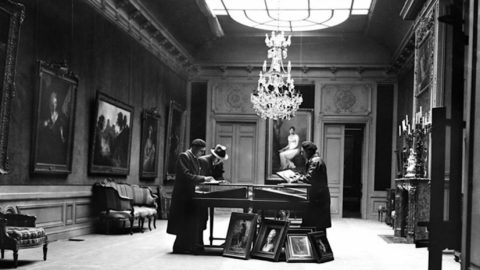Georges Wildenstein, a name that to many means nothing, yet he was one of the most famous art dealers of the last century.
Wildenstein had a decidedly reserved character, perhaps for this reason he is still little known outside the artistic environment, but during the period he worked there was no collector who did not say "I will show this painting to Georges Wildenstein”.
The most private rooms of his gallery in New York housed thousands of paintings worthy of the most famous museums: Rembrant, Rubens, Beato Angelico, Botticelli, Velasques, El Greco is still Tintoretto and Fragonard. His purchasing power was legendary. He had a network of friends and agents all over the world who sent him letters, information, photographs and catalogs or more specific requests for information on works for sale to his Paris studio every day, and his responses were always lapidary.
He had an extraordinary archive of data and images and he was hardly wrong. Each reproduction was accompanied by an introductory note, the bibliography, notes and articles concerning it. When someone brought him a painting by some master of impressionism, it took him five minutes to give a documented opinion.
Wildenstein's might began in the shoulder bag of a draper, Nathan Wildenstein, that in 1870, when the Prussians invaded Alsace, he took refuge in Paris. Nathan was 19 years old, he opened a fabric shop and kept it until one day a customer asked him to sell him a painting. He took the job seriously and not only sold the painting but made a very good profit on it. Thus he began to buy minor works that he found in homes and discovered that he had a formidable nose for art. In the late 1902th century he became one of the five most famous dealers in Paris and in XNUMX he opened a small gallery in New York.
He ran enormous risks in buying entire collections, even of two or three thousand works, so it was said. And he was always ready to raise prices at auction, in principle also valid for shares on the stock exchange.
Tireless, he led a life of work that ran like clockwork. He studied tens of thousands of paintings, cataloging them forever in his memory; he spent all his free time in museums; when he went out by car and saw a church, he would stop and go inside to go and see his works. And with him always the son who accompanied him, Georges.
From an early age he educated him to the "beauty" that art could express. And while the other children played with the toy soldiers he dedicated himself to the illuminated manuscripts. He had private lessons in art history because he was already recognized as an art dealer. He was so good that his father decided to make him the best in the world. And so it was!
At 18, he wanted to start doing it himself and chose the history of art as his field. Thus he began to visit museums and museums and two years later wrote his first article for the Gazette du Beaux-Arts. After an experience as a journalist he bought shares in a publishing house and published some of the first volumes of art illustrated with photogravures. It was a success!
In 1934 Nathan died, aged 83. Georges was 43 and had twenty-five years of experience and despite the difficult period he was able to distinguish himself by gaining international fame.
Georges Wildenstein hardly saw anyone and hid behind his collaborators. Many people who bought works from him even for a lot of money have never seen him. No one has ever caught him phoning a buyer, asking for an appointment, or pushing a sale. He waits! He just stands there like a cat. A cat that becomes a tiger when it has to buy. If a rival got his hands on a famous painting, Wildenstein took it as a personal affront.
The paintings were his life, handed down from father to son out of passion, love and the prestige of being able to hold the true beauty and wealth of the world in his hands: "art".





